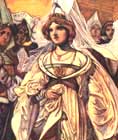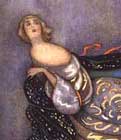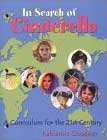
Cinderella:
345 Variants
by Marian
Roalfe Cox
SurLaLune's
Cinderella Area
SurLaLune Fairy Tales Main Page
9
Arnason, Jon, Folk-Tales of Iceland, collected by. Leipzig, 1862-64. (Translation by William Howard Carpenter; published in Folk-lore Record, iii, 237-241.)
"STEP-MOTHER STORY."
ABSTRACT
Widowed King, father of Mjadveig, marries widow. She and her daughter Kroka change at will into giantesses--ill-treated heroine (by step-mother and step-sister)--Mother help (in dream)--Heroine directed by dead mother (1) to pick up kerchief in path; this is stolen from her by step-sister; (2) to follow due of yarn which conducts her to bower where she dwells un seen--Lost shoe; heroine vows she will wed whatever man finds it. King's son puts ashore to visit King; finds shoe, is persuaded by queen that it belongs to her daughter with whom he sails away--Mutilated foot--False bride -- Animal witness (birds in rigging)--Prince lands again at same spot; chances on heroine's bower; sees she wears fellow shoe to one he carries, and bids her put on; takes her to ship, goes to his own country--Happy marriage--Villain Nemesis--Step-sister is burnt and her ashes made into porridge which queen eats; she is then burnt also.
TABULATION
(1) King and queen have only daughter Mjadveig. Queen dies; father and daughter lament at her tomb. King at last advised to marry again; journeys to find wife. Comes to crowd round weeping woman with one daughter named Kroka. She has just lost husband; consents to marry king. People observe that mother and daughter change into giantesses when they think they are alone. King grieves thereat.-- (2) Kroka robs Mjadveig, to whom mother appears in dream1 bidding her take and wear in her bosom what she will find in the path. Heroine looks and finds kerchief. Kroka discovers this and tears it away from her. Heroine, again directed in dream, takes clue of yarn found near path, and this runs before her and conducts her to bower. Here she dwells in comfort and unseen, though able to overlook palace.-- (3) One day she Irises a shoe and vows he will many whatever man finds it.-- (4) Shoe is picked up by a king's son, who has put ashore to visit king at palace. He asks queen whether any costly thing has been lost from treasury. Queen says "Yes"; her daughter complained of having lost something but would not say what. Prince shows shoe at her request; she pretends it is her daughter's and takes it to her. Prince asks to see daughter with shoe on, then offers to marry her, and takes her to his ship. When thy have sailed a short distance, two birds settle in the rigging and say:
"At the prow sits hewn heel,
Full is her shoe with blood;
At home sits Mjadveig
In her golden bower.
Turn back, king's son."
King looks at bride's foot, and finding it mutilated, and that shoes do not match, puts back to land.-- (5) He comes upon Mjadveig's bower, talks to her, and notices that she is wearing fellow shoe to one he carries and bids her put on. Mjadveig tells him that queen and daughter are giantesses. He returns to ship with Mjadveig as his bride, but lets it appear that he intends to marry Kroka. Arrived at his kingdom he sends ship back for Kroka's mother, and meanwhile puts Kroka to death and has body burnt. The ashes are made into porridge and given to queen,2 who says it is good, but makes her thirsty. Voice comes from her throat: "Eat me not, mother." Queen is about to change into giantess when she is fallen upon and killed, and burnt.-- (6) Prince marries heroine; father is present at wedding.
NOTES
Note 4
(P. 143.) In connection with this incident, so common in folk-tales, of the child receiving help from a dead parent, either at the tomb (as in Nos. 33, 38, 64, 70, 96, 147, 153, 197, 199, 204, and hero-tales Nos. 328, 340, 341), or through an apparition in a dream (as in Nos. 9, 10, 202, 277 [311, not in dream]), the following parallels may be cited:--Young Swipday (in the "Lay of Swipday and Menglad", Corpus Poet. Boreale, i, 93), bound by a cruel stepmother to ride into Giant-land and win the giant-guarded maiden of the enchanted castle, raises his dead mother and obtains charms from her, enabling him to accomplish his task. With Swipday compare Ericus Disertus in Saxo (see Rydberg, Teut. Myth., p. 102). In the same way, at the son's adjurstion, a sword is handed out of the tomb in the folk-song of Orm (Sv. fornsanger, 2, 446-7; Danske viser, 1, 59, 60-6-7), and in a Faroe song of Virgar (Lyngbye, p. 369). Wolfdietrich constrains the dead tongue of his buried father to utter seven words (Cod. Dresd., 313). The child talks with the mother at her grave (Rhesa dainos, 22). Eulogies sung at the grave-mound are mentioned in Hallbiörn, p. 859. Raising the dead comes easy to Christian saints, but it was more than Zeus could do: [Greek name], Aesch, Eum., 649. "Linguae defuncti dira carmina ligno insculpta supponere", forces him to speak (Saxo, ed. M., 38); see Grimm, Teut. Myth., 1229, 1693.
Cf. Frere, O. D. D., No. 1, "Punchkin";
Rivière, Contes pop. Kabyles, p. 67, "Les Deux Orphelins";
Kreutzwald, Ehstnische Mar., No. 15; Ralston, R. F. T.,
pp. 159, 259 ff.; Cosquin, ii, 69. Help is obtained at the grave of the
dead mother in Nos. 17, 19,
37, 43, 47,
50, 87, 124,
265, 266; of the helpful
animal in No. 93; of the transformed mother in Nos.
31, 54, 95,
101, 102, 127;
and of the dead father in Nos. 328, 340,
341. Comp. Schiefner, No. 4.
Return to place in text.
Note 5
The stepmother is made to eat her own child in the following stories: Gonzenbach, Nos. 33, 34, 48, 49; Müllenhoff, p. 18; Pitré, No. 59; Rivière, Contes Kabyles, p. 55; Stokes, No. 2; Temple, Legends of the Punjab, p. 64. See also Nos. 9, 10, 68, and 69 of this collection.
In the "Lay of Atli" Gudrun slays her children,
serves their roasted hearts to Atli their father, telling him they are
calves' hearts, and mixes their blood with his drink (Corpus Poeticum
Boreale, i, 343). So the murdered child is served up to the father
in Grimm's "Juniper-Tree"
(No. 47) and variants. Cf. Henderson, Northern Counties, 1st
ed., p.314, "The Rose-Tree"; Magyar Folk-tales, p. 298,
"The Crow's Nest"; and the version from Holderness, ib., p.
418, "Oranges and Lemons." In a story current among the Turanian
tribes of South Siberia (cited by de Gubernatis, Z. M., i, 139,
from Radloff) the hero gives the flesh of his own father to his two wives
to eat. Compare the Cronos myth. Tantalus has his son Pelops cut up and
boiled, and set before the gods. Demeter alone (being absorbed in her
grief) eats of the dish.
Return to place in text.
Cox, Marian Roalfe. Cinderella: Three Hundred and Forty-five Variants of Cinderella, Catskin, and Cap O' Rushes, abstracted and tabulated. London: David Nutt for the Folklore Society, 1893.
While the original text of this book is out of copyright, the special formatting and compilation available on SurLaLune Fairy Tales is copyrighted. Be aware that while the original content has been honored, page numbering, footnote numbering, redesigned charts, links, and other aspects are unique to this site's version of the text. Use at your own risk. For private and fair use educational purposes only.
©Heidi
Anne Heiner, SurLaLune Fairy Tales
E-mail: surlalune@aol.com
Page last updated February 1, 2006
www.surlalunefairytales.com










